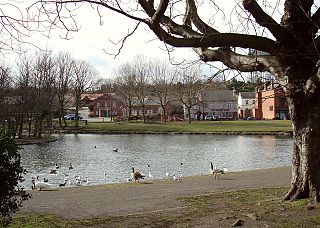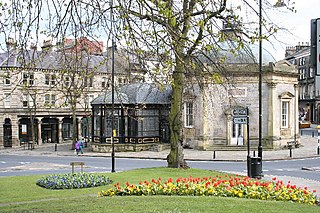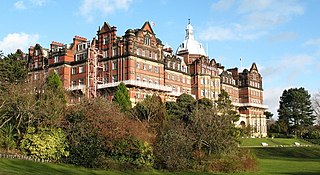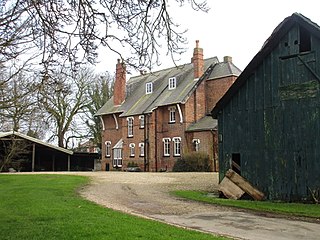
Harrogate is a spa town in the district and county of North Yorkshire, England. Historically in the West Riding of Yorkshire, the town is a tourist destination and its visitor attractions include its spa waters and RHS Harlow Carr gardens. 13 miles (21 km) away from the town centre is the Yorkshire Dales National Park and the Nidderdale AONB.

Askern is a town and civil parish within the City of Doncaster, in South Yorkshire, England. It is on the A19 road between Doncaster and Selby. Historically part of the West Riding of Yorkshire, it had a population of 5,570 at the 2011 Census. Askern was also known in for its Greyhound Stadium, which closed in 2022.

The Old Swan Hotel in Harrogate, North Yorkshire, England, is part of the Classic Lodges group.

St Patrick's Church, Patrington is an Anglican parish church located in Patrington, East Riding of Yorkshire, England. The church is a Grade I listed building.

The Royal Pump Room is a Grade II* listed building in Harrogate, North Yorkshire, England. Today it houses the town's museum – operated by North Yorkshire Council. It was formerly a spa water pump house. It is located in Crown Place in the western part of Harrogate town centre, opposite the town's Valley Gardens park. It is bounded by two streets, Crescent Road and Royal Parade. Today, the Pump Room consists of both the original 1842 stone rotunda and a glazed annexe which was opened in 1913. The Pump Room offered guests of the town an all weather facility where they could drink sulphur water which was pumped on site from a natural spring known as the Old Sulphur Well. The building also had a social element to it as it provided guests with a place to meet friends and get to know others.

Tewit Well, also known in its early days as "Tuit" or "Tuewhit", is a spa water well, the first chalybeate source discovered in Harrogate, North Yorkshire, England.

The Majestic Hotel or Hotel Majestic, now officially known as the DoubleTree by Hilton Harrogate Majestic Hotel & Spa, is a hotel in Harrogate, North Yorkshire, England.

Kingston House is a tower block and low rise office development built in Kingston upon Hull, England, in the 1960s in a modernist style.

Bewholme Vicarage, in the village of Bewholme, East Riding of Yorkshire, England, is a former vicarage designed by the architect William Burges in 1859. It is a Grade II listed building and is now a private residence.

The Church of St Helen, Kilnsea, Holderness, East Riding of Yorkshire, England, is a redundant parish church dating from 1864–5. It was designed by the architect William Burges, and partly paid for by his father Alfred Burges, and is a Grade II listed building.

The Church of St Helen, Barmby on the Marsh, East Riding of Yorkshire, England is a redundant church which is now in the care of the Friends of Friendless Churches. The church is recorded in the National Heritage List for England as a designated Grade II listed building.

The Foords Hotel is a historic public house in Filey, a town in North Yorkshire, in England.

The Granby Hotel is a historic building in Harrogate, a town in North Yorkshire, in England.
Harlow Moor is a ward in the town of Harrogate, North Yorkshire, England. It contains 23 listed buildings that are recorded in the National Heritage List for England. Of these, one is listed at Grade I, the highest of the three grades, one is at Grade II*, the middle grade, and the others are at Grade II, the lowest grade. The ward is to the west of the centre of the town, containing part of Low Harrowgate, and the area of Harlow Hill. It is mainly residential, with remnants of the town's history as a spa town. Within the ward are the Valley Gardens and RHS Garden Harlow Carr, both of which contain listed buildings. The other listed buildings include houses, cottages and associated structures, hotels, bridges, churches, an observation tower, a water tower, a set of lamp posts, and a pavilion and colonnade.

The Cedar Court Hotel is a historic building in Harrogate, a town in North Yorkshire, in England.
Low Harrogate is a ward in the town of Harrogate, North Yorkshire, England. It contains 56 listed buildings that are recorded in the National Heritage List for England. Of these, five are listed at Grade II*, the middle of the three grades, and the others are at Grade II, the lowest grade. The ward is in the centre of the town, and some of its listed buildings reflect its history as a spa town. Others are commercial buildings, public buildings, houses and associated structures, offices and shops, and the others include churches, a boundary marker, hotels and public houses, almshouses, memorials, a theatre and a concert hall, and lamp posts.

1-4 West Park is a historic terrace in Harrogate, a town in North Yorkshire, in England.

The Crown Hotel is a historic building in Harrogate, a town in North Yorkshire, in England.
Stray is a ward in the town of Harrogate, North Yorkshire, England. It contains ten listed buildings that are recorded in the National Heritage List for England. Of these, two are listed at Grade II*, the middle of the three grades, and the others are at Grade II, the lowest grade. The ward is to the south of the town, it is residential, and includes the area of parkland known as The Stray. The listed buildings consist of houses, two well heads, two churches, and two lamp posts.

St John's Well is a spa water well in Harrogate, a town in North Yorkshire, in England.


















